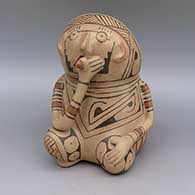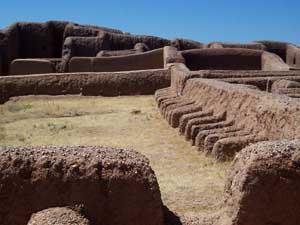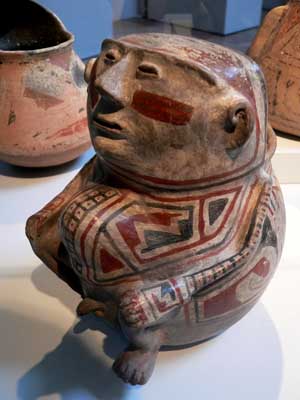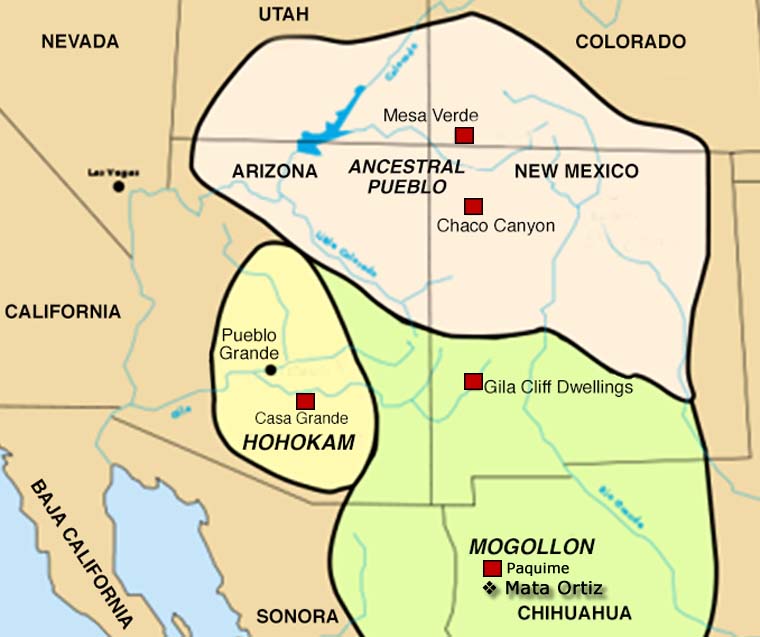
Manuel Olivas
1941-2007
Mata Ortiz and
Casas Grandes

Manuel Olivas Quintana was a potter who lived most of his life in Nuevo Casas Grandes, the city nearest to the village of Mata Ortiz. As a teenager he was digging in various of the ancient sites around Paquimé and pulling out ancient pottery. There was a huge market in ancient pots back then, before the Mexican government enacted (and enforced) their Antiquities Preservation Laws. The market was so big it quickly got hard to find old pots.
When he was 10 years old, Manuel's grandmother, Leonor Parra, showed him where to find clay, how to work with it, decorate it and fire it. His pots were rough at first but he got better quickly. He got so good it was next to impossible to determine if a pot was ancient or if Manuel had made it last month. By the time he was 15 he was selling Paquimé replicas to American traders and dealers. According to Jim Hills, Manuel was possibly the first (and best) of the known replicators of ancient Paquimé pottery.
There were also other young men scouring the area looking to find old pots, or to learn how to make new ones and then make them look old. The Antiquities Act ended all thoughts of making anything look old: if it looked like it might be old to a young Army officer who likely couldn't tell the difference, you just might have everything you own seized and you might go to jail yourself. Several of the early potters in Mata Ortiz went to jail that way. So in the early 1960s, the digging for old pots stopped and all talk around the area turned to how to make new pots that were unquestionably new pots.
Sooner or later, all the earliest potters in Mata Ortiz visited with Manuel to get help with sticky points in their process. That included Emeterio Ortiz, Felix Ortiz, Salbador Ortiz, Macario Ortiz, Chevo Ortiz, Nicolás Ortiz, Osbaldo Ortiz, Rojelio Silveira and Juan Quezada, Sr. When Juan Quezada, Sr. finally worked out how to make a black paint that stuck to the pot after firing and remained black, he went straight to Manuel and gave him the first sample.
In those early days, as it was in the pueblos years ago, the making of pottery was a community thing with lots of discussion, sharing of ideas and joint experimentation. Manuel may have been one of the first Paquimé-Revival potters in the area but he also asked questions of the others and they shared what they knew with him.
One of the services Juan Quezada Sr. offered when he was touring around the United States with Spencer MacCallum was that he would examine anyone's old Casas Grandes or Paquimé pottery and tell them if it was real or fake. He determined that a lot of the supposedly antique pottery was fake. In many cases, he said the pieces had been made by Manuel.
In the early years, Manuel worked by himself. After he married, his wife, Maria Cruz Orieto Olivas, helped him, but in his later years he worked with his daughter, Blanca. Blanca made, sanded and polished the pots while Manuel painted and ground-fired them.
Toward the end of his life, Manuel received official permission from Mexico's National Institute of Anthropology and History to make and sell authentic copies of Ramos Polychrome figures. Ramos Polychrome was a very distinctive style of pottery that essentially lived and died in the ancient city of Paquimé, between about 1250 and 1450 CE. The most distinctive part of Ramos designs were the black outlines: the previous Babicora Polychromes had red and black designs but no outlining. Ramos Polychromes also showed more zoomorphs, animals and other figurative designs. The timing also coincides with an increase in the quality of the finished products at the same time as a projected influx of migrants from the abandoned Mimbres Valley pueblos to the north.
100 West San Francisco Street, Santa Fe, New Mexico 87501
(505) 986-1234 - www.andreafisherpottery.com - All Rights Reserved

Mata Ortiz and Casas Grandes

The macaw pens at Paquimé
Casas Grandes is both a municipality and an archaeological district in northern Chihuahua State, Mexico. The archaeological district includes the pre-historic ruins of Paquimé, a city that began to build around 1130 AD and was abandoned about 1450 AD. Archaeologists are uncertain as to whether Paquimé was settled by migrants from the Mogollon/Mimbres settlements to the north or by Anasazi elite from the Four Corners region in the United States or by others. Over the years Paquimé was built into a massive complex with structures up to six and seven stories high with multiple Great Houses in the surrounding countryside. Today, the site is a UNESCO World Heritage Site.
Mata Ortiz is a small settlement inside the bounds of the Casas Grandes municipality very near the site of Paquimé. The fortunes of the town have gone up and down over the years with a real economic slump happening after the local railroad repair yard was relocated to Nuevo Casas Grandes in the early 1960's. The town was in steady decline until Juan Quezada, a poor farmer who gathered firewood in the area of the archaeological site, was inspired by fragments of ancient Paquimé pottery and even older fragments of Mimbres forms with bold black-on-white designs littering the ground to learn more.

Ramos Polychrome effigy pot from Paquimé
Quezada was successful in his quest to learn to recreate the ancient process using slightly more modern techniques (although no one in the present tradition uses a potter's wheel). He learned to use sand and other coarse materials for temper. He discovered that dried cow dung made an excellent and inexpensive firing fuel. Instead of using gourds for smoothing he substituted broken hacksaw blades. Instead of using yucca fiber brushes for painting he learned to make brushes with human hair. He persevered in his efforts and by 1971 had produced a kind of polychrome pottery. Since then, most pottery-making in the area has used innovations in the design and decoration of the pots but the materials and the basic crafting of the process have remained the same.
By the mid-1970s, Quezada had attracted a significant number of traders and his work was becoming a commercial success. That is when he began teaching his techniques to his immediate family. They in turn taught other family members, friends and the younger generations. Both women and men were included from the beginning.
Originally called Casas Grandes pottery in the early years of its production, the potters of this tiny village have made such an impact on the pottery communities, including many awards and special recognition from the Presidents of Mexico, that Mata Ortiz pottery is now becoming known around the world.
Today, pottery production has changed the village in many ways as there is now electricity, plumbing, vehicles and more for the residents. Virtually everyone in the small town (2010 population: 1,182) makes their living by working in some part of the pottery-making process, from potters to clay-gatherers to firewood collectors to traders.
Mata Ortiz pottery incorporates elements of contemporary and prehistoric design and decoration, and each potter or pottery family produces their own distinctive, individualized ware. Young potters from surrounding areas have been attracted to the Mata Ortiz revival and new potting families have developed while the art movement continues to expand. Without the restraints of traditional religious practices or gender constraints, a vibrant flow of new ideas has enabled the pottery of Mata Ortiz to avoid the derivative repetition common to virtually all folk art movements. This blend of economic need, gender equality, cultural expression and artistic freedom has produced a unique artistic movement in today's community.
Lower photo is courtesy of David Monniaux, Creative Commons Attribution-Share Alike 3.0 Unported License
100 West San Francisco Street, Santa Fe, New Mexico 87501
(505) 986-1234 - www.andreafisherpottery.com - All Rights Reserved
